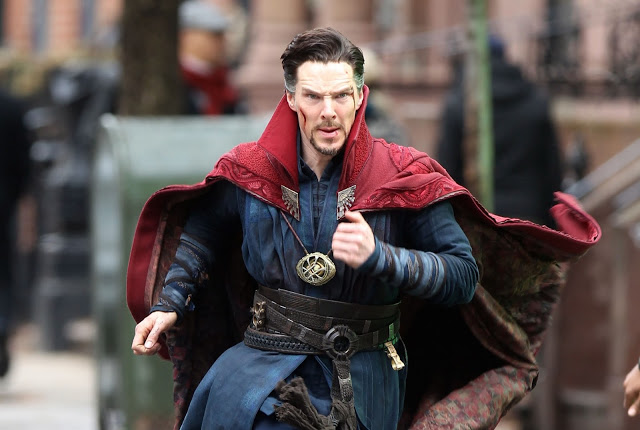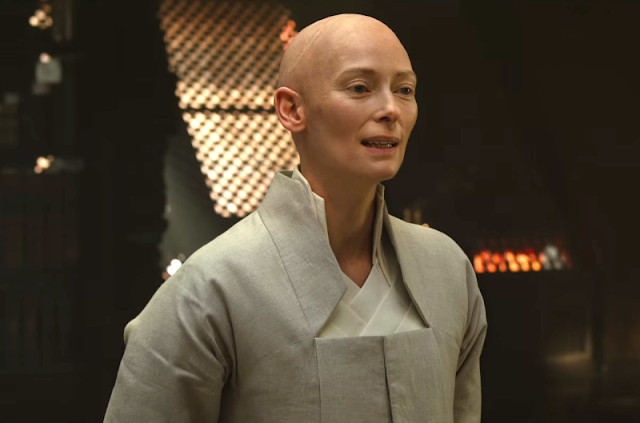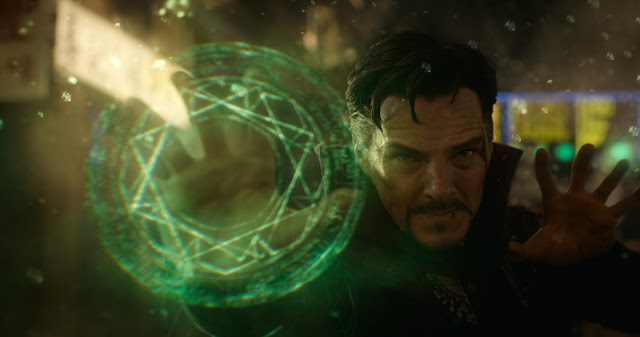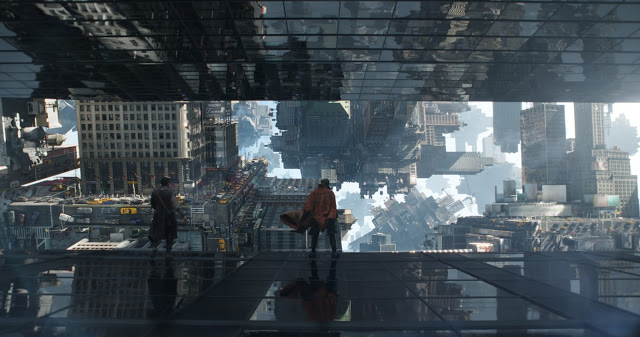Doctor Strange opens with a dizzying, disorienting sequence of eye-popping incredulity. Somewhere in a South Asian monastery, a man in a robe rips a few pages out of a heavy, important-looking book, then flees from a hooded figure. While running, the man waves his hands and opens a portal to a different continent, and the action suddenly shifts to a brightly lit European metropolis. There, rather than engaging in hand-to-hand fighting, the combatants somehow will objects into motion, and their very surroundings—the buildings, the pavement, the sky itself—seem to twist and contort around them. When I watched this scene, I had absolutely no idea what was happening; now, having seen the entire film, my understanding is only marginally improved. Yet while I was (and remain) clueless, I was nevertheless riveted by the sheer vigor of the filmmaking, the visual dynamism and formal audacity. The ability to induce this sensation—a feeling of awestruck confusion and slack-jawed wonder—is the greatest achievement of Doctor Strange. It may not make a lick of sense—the more it attempts to clarify itself, the more tedious it becomes—but damn is it cool.
Eventually, anyway. Setting aside its discombobulating prologue, the opening act of Doctor Strange functions as a reliably formulaic superhero origin story. Its protagonist, Stephen Strange, is a supercilious New York neurosurgeon, the kind of only-in-the-movies doctor who routinely performs impossible procedures with unmatched skill and unflappable calm. He is as callous as he is capable, and while he may be a medical genius, he’s something of a social misfit; it’s almost as if Sherlock Holmes has swapped out his pipe and deerstalker cap for a surgical mask and gloves. That impression, of course, is hardly coincidental: Strange is played by Benedict Cumberbatch, the immensely talented English actor who first wriggled his way into most viewers’ hearts as the titular detective on the BBC’s Sherlock. Here, he’s just as smart but even more disdainful. When he pauses during a particularly perilous operation to tell a subordinate to stifle his wristwatch (because its ticking second-hand is interfering with his concentration), you can taste the haughty intelligence dripping off him.
Like most movie geniuses—including Alan Turing, the mathematical savant whom Cumberbatch portrayed brilliantly in The Imitation Game—Strange is a solitary creature; he has a cordial relationship with his ex-lover and current colleague, Christine (Rachel McAdams, underused but funny), but beyond that, he has no apparent need for other people. That changes when he suffers a catastrophic car wreck (the film’s closing credits actually admonish viewers not to drive while distracted), which ravages his hands and robs him of his one true love: his work. Distraught, Strange drains his life savings on experimental treatments to restore his hands, but when nothing works, he follows an obscure tip and makes his way to Nepal. There, having acquired the scruffy facial hair that signifies when a formerly polished movie character has fallen into true despair, he meets a warrior named Mordo (Chiwetel Ejiofor, always good), as well as a mysterious, bald woman known only as The Ancient One (a relatively flat Tilda Swinton). How can these mystics with no medical training fix his deformity? Easy: They’re wizards.
Actually, “sorcerers” is the preferred nomenclature. In any event, it’s at this point that Doctor Strange begins to distinguish itself from the typical Marvel movie, for better and worse. As the Ancient One explains to an increasingly dubious Strange, Earth is but a single planet within an infinite number of dimensions, and she and her charges harness power from those other dimensions in order to influence their present realm. Or something like that. I will leave it to comic-book aficionados and industrious teenagers to elucidate the particulars of this film’s intricate, labyrinthine world-building. The point is that for the good doctor to recover his surgical skills, he needs to learn magic.
That presents significant challenges, not just to Strange but to Scott Derrickson, the movie’s able and energetic director. A fun concept for fantasy literature, magic is a notoriously difficult conceit to translate into cinematic language; even the Lord of the Rings and Harry Potter pictures largely (and wisely) avoided extended sequences of wand-waving and pantomiming. Yet Derrickson, a horror veteran, mostly pulls it off, creating a cognizable grammar that both looks chic and makes intuitive visual sense. He develops a color scheme—most of the holographic imagery on display is either yellow or red, but when Strange exercises his powers, spindly green light tends to emanate from his fingers—that helps identify what’s happening and how it impacts the real world. And while there are only so many ways an actor can furrow his brow to emulate the act of conjuring a spell, Cumberbatch effectively sells Strange’s gradual maturation from struggling neophyte to practiced mage.
More impressively, Doctor Strange’s set pieces are entirely distinct from any that have yet taken place in the MCU. Comic-book movies are now so ubiquitous, I had thought I’d already seen every possible variation on computer-aided superhero combat. Yet here, the action is less about the fighters than their environs. Taking obvious inspiration from Inception (as well as The Matrix), Derrickson concocts one sequence after another in which physical space is unpredictably, thrillingly fluid. If Stranger Things introduced us to the upside-down, Doctor Strange gives us the full 360-degree treatment: Walls bend from vertical to horizontal, open air splits into cracking glass, floor becomes ceilings and vice-versa.
If that sounds overwhelming, it is, but Derrickson still maintains an aesthetic logic that somehow makes internal sense. He also—and this is something I say quite rarely—makes spectacular use of 3-D. By setting his action along multiple planes, he creates an expansive frame, and the extra dimension contributes to the film’s heady atmosphere of exploratory possibility. It’s the best use of 3-D technology in any movie since Gravity.
Amid this rush of intoxicating, panoramic lunacy, it’s a shame that Doctor Strange feels compelled to try to make sense out of everything. The screenplay, credited to Derrickson, Jon Spaihts, and C. Robert Cargill, contains heaps of exposition, discussing things like relics, sanctums, astral planes, and multi-verses. It’s all part of Marvel’s dutiful commitment to franchise-building— the utterance of the words “infinity stone” will surely set fanboys aflutter—but it’s still nonsense. The irony is that all of this relentless annotation weighs the film down, preventing it from soaring into space and instead just reminding you how foolish it is. If the most reliable way for a comedian to ruin a joke is to explain it, then the surest way for a comic-book movie to thwart suspension of disbelief is to reiterate its believability.
In fact, perhaps the most damaging element of Doctor Strange is that it’s a Marvel movie at all, or rather, that it’s an official entry in the MCU’s Phase Three. Despite a mid-credits stinger that teases Strange’s participation in an upcoming Thor adventure, it’s unclear how this film—with its countless dimensions and alternate realms, its time travel and magic—can be realistically integrated into the studio’s existing, Avengers-centric output. (One of the most refreshing things about Guardians of the Galaxy—still, on balance, the MCU’s best movie—was that it stood mostly apart from its earthbound cousins.) Of course, realism in the narrative sense is hardly a concern for Marvel; the corporate behemoth is happy to continue cramming all of its superheroes together into as many bloated quests as possible, regardless of sensibility or coherence. But if Derrickson hadn’t been tethered to Marvel’s prime directive (to steal a term from a different franchise), it’s possible he could have made a different, freer picture that properly capitalized on his facility with the bizarre.
If nothing else, perhaps he could have cured the MCU’s epidemic of lackluster villains. Instead, that sickness continues here with Kaecilius, a disgruntled former student of The Ancient One who, despite Mads Mikkelsen’s screen presence and comic timing, fails to develop any real menace or personality. (He does, however, sport some truly terrible eye makeup.) And while the screenplay features a half-clever and unexpected anticlimax—one that continues the noble work, along with this past summer’s Captain America: Civil War, of reversing the irksome trend of every comic-book movie concluding with a bloated, mindless action extravaganza—its ending also inadvertently highlights the impotence of its heavies.
“This doesn’t make sense,” Strange protests upon learning of The Ancient One’s magic. She responds, “Not everything has to.” I quite agree. And Doctor Strange is at its best when it’s at its weirdest, such as when Strange dons the Cloak of Levitation, a blood-red garment that has a mind of its own and that is the most reliably funny piece of sentient cinematic fabric since the magic carpet in Aladdin. That level of quirky detail goes a long way in establishing the film’s odd, trippy tone. But it’s hard not to wonder if there’s another dimension out there, one where this fun, flawed movie is just a little bit stranger.
Jeremy Beck is the editor-in-chief of MovieManifesto. He watches more movies and television than he probably should.




